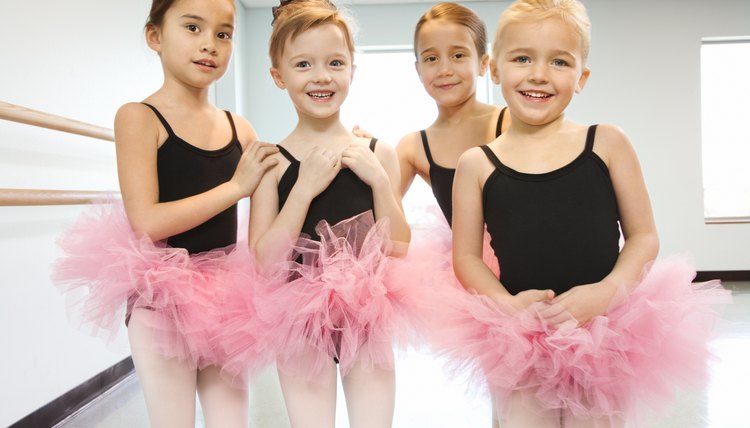How to Teach Ballet to Kids

Even if you’ve spent years training as a dancer, the prospect of teaching ballet to little ones can be overwhelming. It’s no easy task to turn high-energy kids into well-disciplined, highly focused dancers. Before you head into the dance studio, make sure your goals and expectations for the class are clear and reasonable. If you're working with children younger than 7, realize kids this age generally lack the coordination and focus required for proper ballet training. Whatever age group you'll be teaching, you’ll need a lot of creative and physical energy, as well as some proven disciplinary techniques up your sleeve, to keep your students -- and you -- smiling.
Age Considerations
Jane Bonbright of the National Dance Education Organization notes that teaching lessons that are not age-appropriate can leave kids overwhelmed, so acknowledge your kids' cognitive and physical abilities as you design your syllabus. Kids ages 3 to 5 tend to have short attention spans, so don't expect them to stand still for lengthy demonstrations or explanations. Creative movement accompanied by songs, stories and "pretending" works particularly well at this age. Children ages 6 to 8 generally have greater powers of concentration than their younger peers. They can be silly and expressive, but they also enjoy learning actual ballet steps and proper dance terminology. From 9 and older, children develop greater physical self-awareness and focus. Over time and with effort, kids of this age can make steady progress in ballet, learning to control their bodies and perform complex movement patterns involving the head, arms and legs.
Class Format
Kids in the youngest age category might be self-involved and rambunctious, but they also love to imitate. Seat kids in a circle or lead them across the room, always making yourself the focus of attention of the kids. Plan to model every move, teaching with energy and enthusiasm from the moment the students enter the studio until the final curtsy. Kids older than 6 or 7 benefit from a brief "circle time" at the beginning of class, followed by beginning-level work at the barre, in the center and across the floor. With older groups, you can probably spend longer periods of time working at the barre, where you'll emphasize essential ballet concepts such as alignment, turnout and proper use of the head and shoulders. At every age level, you'll need to assess the class as a whole to determine how much formal technique students can handle. Introducing too much material too soon or pushing too hard can turn kids off.
Types of Moves
For preschoolers, a warm-up can include high-energy marches in place, butterfly stretches and seated toe touches, followed by jumps in place, and walking and skipping across the floor. Plan to move quickly through your lesson plan, switching activities every few minutes to keep kids involved. Older children can begin building a movement vocabulary that includes plies, releves and chasses -- or knee bends, toe rises and gallops. Children with more patience, concentration, coordination and self-control can practice basic ballet barre exercises designed to develop strength and flexibility in the feet and legs. These should be followed by exercises in the center and across the floor, all of which emphasize body placement, balance and grace. All students, regardless of age, should finish with stretches and curtsies to the teacher.
Expert Insight
To ensure that your classes run smoothly, devise a clear set of rules and review them periodically with the children. If your students tend to talk too much in class, dance instructor Nichelle Strzepek suggests inviting children to speak about themselves for the first few minutes of every class, before they "become dancers." Kids like and generally respond well to structure and repetition, so make sure to repeat lessons from week to week. At the same time, you always should prepare more material than you think you'll need, especially for preschoolers. Always have a surplus of stories, silly songs, movement games and colorful props available to keep class lively and fresh. If a student is misbehaving during class, Strzepek suggests enlisting her help, selecting her to serve as line leader or to distribute scarves or flowers. With older kids, make sure your praise is genuine, reflecting real improvements.
References
- Ballet: From the First Plie to Mastery: An Eight-Year Course; Anna Paskevska
- Dance Magazine: Teaching Tots
- Dance Teaching Methods and Curriculum Design; Gayle Kassing and Danielle Mary Jay
- Inside Ballet Technique: Teaching Creative Movement
- Inside Ballet Technique: Teaching Pre-Ballet and Beginning Ballet
- Dance Advantage: 12 Tips for Teaching Tots
Writer Bio
Judy Fisk has been writing professionally since 2011, specializing in fitness, recreation, culture and the arts. A certified fitness instructor with decades of dance training, she has taught older adults, teens and kids. She has written educational and fundraising material for several non-profit organizations and her work has appeared in numerous major online publications. Fisk holds a Bachelor of Arts in public and international affairs from Princeton University.
